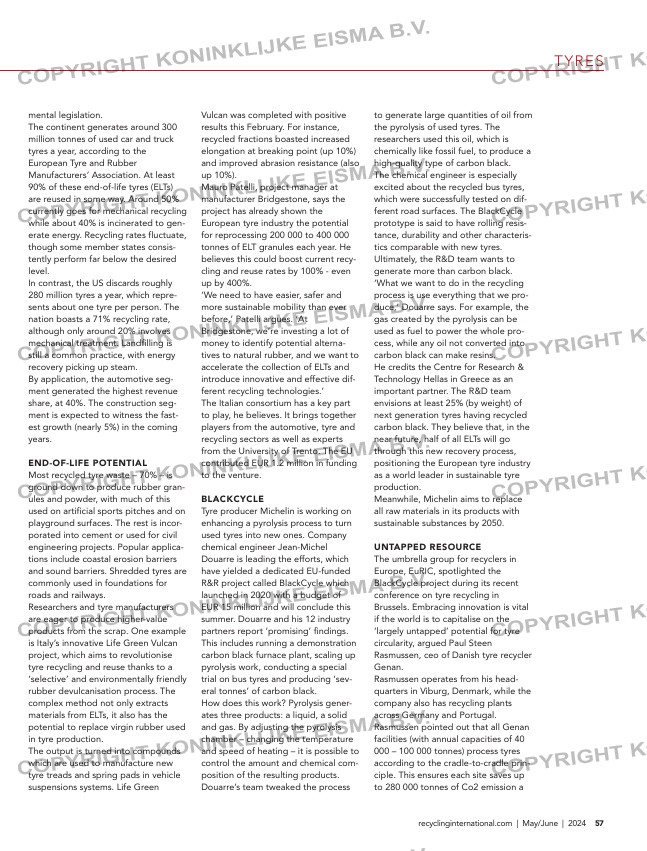Page 57 from: What’s inside?

57recyclinginternational.com | May/June | 2024
TYRES
mental legislation.
The continent generates around 300
million tonnes of used car and truck
tyres a year, according to the
European Tyre and Rubber
Manufacturers’ Association. At least
90% of these end-of-life tyres (ELTs)
are reused in some way. Around 50%
currently goes for mechanical recycling
while about 40% is incinerated to gen-
erate energy. Recycling rates fluctuate,
though some member states consis-
tently perform far below the desired
level.
In contrast, the US discards roughly
280 million tyres a year, which repre-
sents about one tyre per person. The
nation boasts a 71% recycling rate,
although only around 20% involves
mechanical treatment. Landfilling is
still a common practice, with energy
recovery picking up steam.
By application, the automotive seg-
ment generated the highest revenue
share, at 40%. The construction seg-
ment is expected to witness the fast-
est growth (nearly 5%) in the coming
years.
END-OF-LIFE POTENTIAL
Most recycled tyre waste – 70% – is
ground down to produce rubber gran-
ules and powder, with much of this
used on artificial sports pitches and on
playground surfaces. The rest is incor-
porated into cement or used for civil
engineering projects. Popular applica-
tions include coastal erosion barriers
and sound barriers. Shredded tyres are
commonly used in foundations for
roads and railways.
Researchers and tyre manufacturers
are eager to produce higher-value
products from the scrap. One example
is Italy’s innovative Life Green Vulcan
project, which aims to revolutionise
tyre recycling and reuse thanks to a
‘selective’ and environmentally friendly
rubber devulcanisation process. The
complex method not only extracts
materials from ELTs, it also has the
potential to replace virgin rubber used
in tyre production.
The output is turned into compounds
which are used to manufacture new
tyre treads and spring pads in vehicle
suspensions systems. Life Green
Vulcan was completed with positive
results this February. For instance,
recycled fractions boasted increased
elongation at breaking point (up 10%)
and improved abrasion resistance (also
up 10%).
Mauro Patelli, project manager at
manufacturer Bridgestone, says the
project has already shown the
European tyre industry the potential
for reprocessing 200 000 to 400 000
tonnes of ELT granules each year. He
believes this could boost current recy-
cling and reuse rates by 100% – even
up by 400%.
‘We need to have easier, safer and
more sustainable mobility than ever
before,’ Patelli argues. ‘At
Bridgestone, we’re investing a lot of
money to identify potential alterna-
tives to natural rubber, and we want to
accelerate the collection of ELTs and
introduce innovative and effective dif-
ferent recycling technologies.’
The Italian consortium has a key part
to play, he believes. It brings together
players from the automotive, tyre and
recycling sectors as well as experts
from the University of Trento. The EU
contributed EUR 1.2 million in funding
to the venture.
BLACKCYCLE
Tyre producer Michelin is working on
enhancing a pyrolysis process to turn
used tyres into new ones. Company
chemical engineer Jean-Michel
Douarre is leading the efforts, which
have yielded a dedicated EU-funded
R&R project called BlackCycle which
launched in 2020 with a budget of
EUR 15 million and will conclude this
summer. Douarre and his 12 industry
partners report ‘promising’ findings.
This includes running a demonstration
carbon black furnace plant, scaling up
pyrolysis work, conducting a special
trial on bus tyres and producing ‘sev-
eral tonnes’ of carbon black.
How does this work? Pyrolysis gener-
ates three products: a liquid, a solid
and gas. By adjusting the pyrolysis
chamber – changing the temperature
and speed of heating – it is possible to
control the amount and chemical com-
position of the resulting products.
Douarre’s team tweaked the process
to generate large quantities of oil from
the pyrolysis of used tyres. The
researchers used this oil, which is
chemically like fossil fuel, to produce a
high-quality type of carbon black.
The chemical engineer is especially
excited about the recycled bus tyres,
which were successfully tested on dif-
ferent road surfaces. The BlackCycle
prototype is said to have rolling resis-
tance, durability and other characteris-
tics comparable with new tyres.
Ultimately, the R&D team wants to
generate more than carbon black.
‘What we want to do in the recycling
process is use everything that we pro-
duce,’ Douarre says. For example, the
gas created by the pyrolysis can be
used as fuel to power the whole pro-
cess, while any oil not converted into
carbon black can make resins.
He credits the Centre for Research &
Technology Hellas in Greece as an
important partner. The R&D team
envisions at least 25% (by weight) of
next generation tyres having recycled
carbon black. They believe that, in the
near future, half of all ELTs will go
through this new recovery process,
positioning the European tyre industry
as a world leader in sustainable tyre
production.
Meanwhile, Michelin aims to replace
all raw materials in its products with
sustainable substances by 2050.
UNTAPPED RESOURCE
The umbrella group for recyclers in
Europe, EuRIC, spotlighted the
BlackCycle project during its recent
conference on tyre recycling in
Brussels. Embracing innovation is vital
if the world is to capitalise on the
‘largely untapped’ potential for tyre
circularity, argued Paul Steen
Rasmussen, ceo of Danish tyre recycler
Genan.
Rasmussen operates from his head-
quarters in Viburg, Denmark, while the
company also has recycling plants
across Germany and Portugal.
Rasmussen pointed out that all Genan
facilities (with annual capacities of 40
000 – 100 000 tonnes) process tyres
according to the cradle-to-cradle prin-
ciple. This ensures each site saves up
to 280 000 tonnes of Co2 emission a
Fotobijschrift
KADERKOP
??
56-57-58-60-61-62_tyrestrendsbestpractices.indd 57 25-04-2024 09:35



